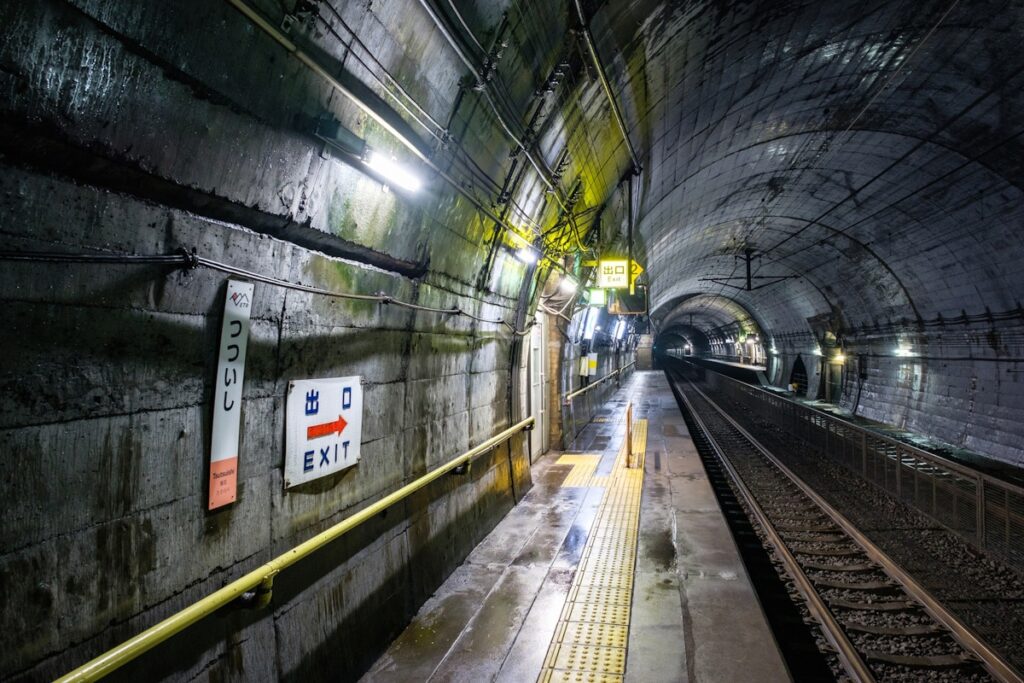[ad_1]
We’ve written about interesting train stations in Japan – from ones out in the middle of nowhere to stations in Tokyo that hardly anyone uses. But there’s an even more interesting – and spooky – type of station. Learn about Japan’s “mole stations” and how you can check them out yourself (if you dare…).
Hey, someone’s using it…

Japan is home to over 9,000 train stations (9,024 in 2022, according to one source I found). The busiest among them, not surprisingly, are in Tokyo, where Shinjuku, Shibuya, and Ikebukuro Stations take the first three places. The three stations combined see over 7 million users daily.
Not every station is so well-traveled, of course. Tokyo also has stations such as Naganuma Station (3,570 users/day) and Minami Shinjuku Station (3,588 visitors/day) that practically no one uses. They continue to exist because, for the people who do use them, they’re indispensable.
If you want a truly unused train station, there are even more stark examples outside of Tokyo. Take poor Tsubojiri Station in Miyoshi, Tokushima Prefecture. Statistics from 2021 show that this remote station averages two passengers a day.
You built a station where?!
But these stations are all above-ground. Some train stations in Japan truly put the “sub” in “subway.” These are the ones based within bored-out tunnels. You board the train in darkness and you leave the train in darkness. They often go by the nickname “mole stations” (モグラ駅) in Japanese.
These stations are a subset of a group of stations known as 秘境駅 (hikyou-eki) – secluded or out-of-the-way stations, which the Web site Blowin’ in the wind, Unnamed Station catalogs in detail. Most exist underground because of geological circumstances – i.e., the area needed a station, and inside of a tunnel was the only place to put it. In at least one case (Tsutsuishi Station), the station exists despite attempts by its owners to abolish it.
Advertisements
There are six of these spooky tunnels in Japan, which JBPress author Maikmura Akiko described in detail in an article this month. Take a tour with us as we examine some of Japan’s most hauntable station stops.
Japan’s mole stations
Tsutsuishi Station (筒石駅)

Rail line: Nihonkai Hisui
Located in Itoigawa City in Niigata Prefecture, this station exists in the Kubiki Tunnel, the longest tunnel in Japan not owned by Japan’s ubiquitous Japan Railways Group. The station was first constructed in 1911 and was scheduled to be scrapped in 1965. However, after fierce opposition from the citizens of the nearby town of Nou (能生), officials decided to move it to its current location. The current station opened in 1969.
The stop is 40 meters underground from the surface station itself, which means a long, dire climb up a staircase that looks like zombies are about to pop out from the walls. Makimura describes this station as so desolate that, when no one else is there, “the only sound that reverberates is your own footfalls.” In summer, the tunnel fogs up, making it somehow even more spooky.
Doai Station (土合駅)

Rail line: JR Joetsu
This station in Gunma Prefecture’s Minakami is nicknamed “Japan’s number 1 mole station”. It’s not hard to see why. The south platform is a good 70 meters underground. It consists of 462 steps, which take around 10 minutes to climb. (It’s also inaccessible to the handicapped – there’s no elevator or escalator.) Once you arrive at the top of the staircase, there’s a sign reading お疲れ様 (otsukare-sama, “good job” – or, maybe in this context, “you made it”).

The station is located in the Shin Shimizu Tunnel. Constructed in 1967, the tunnel was placed under the existing Shimuzu Tunnel, putting it even deeper underground. Hence the long Death March to the top.
Yubiso Station (湯檜曽駅)

Rail line: JR Joetsu
One of the next steps on the Joetsu line, Yubiso is also located in Minakami. Originally stood up in 1931, the station moved to its current location as part of the construction of the Shin Shimuzu Tunnel. Originally, it was a manned station but became officially unmanned in 1985. In 1987, JR took over the tiny station, whose entrance looks like a roomy walk-in closet.

Yunishigawa Onsen Station (湯西川温泉駅)
Rail line: Aizukinugawa Line
You need to cross the Yunishi River to get to the Yunishigawa Onsen area in Tochigi Prefecture’s Nikko. That means crossing the Yunishigawa Bridge – and getting off the train on the tunnel on the other side. Since the river is right at the mouth of the tunnel, riders have to get off in dank, musty darkness.
Fortunately, unlike Doai, there’s no death climb to get out of this tunnel. And the reward is you’re in a beautiful onsen town surrounded by nature.
Misashima Station (美佐島駅)

Rail line: Hokuetsu Express Corporation Hokuhoku Line
We go back to Niigata Prefecture for our next mole station, which looks like a forest ranger outpost from the outside. The stop, inside the 10km-long Akakura Tunnel, is about 10 meters down from the actual station.
The super-fast Hakutaka used to travel this route and visit this station, blasting through the tunnel at speeds of up to 150 km/h. However, Hokuetsu decommissioned this train after the Hokuriku Shinkansen was extended between Nagano and Kanazawa.

One remnant of the station’s days of serving fast-moving trains is a massive steel wind breaker door, which rests on a spring trigger, that separates the home platform from the passing trains. Engineers installed this after realizing that the fast-passing trains could produce violent winds as they passed through the narrow Akakura Tunnel.

This is a fairly young station, dating back only to 1997 when Hokuetsu opened the line itself. Why does it exist? According to Makimura, that’s a damn good question! It’s right next to a major prefetcural highway and there are no major towns or villages nearby. No one can seem to explain why this station was worth the time and expense to build.
Taikenkodo Station (体験坑道駅)
Rail line: Seikan Tunnel Tappishako Line
Here’s a station for the diehard railway fan. This station was purpose-build for the so-called “Mole Car”, a cable car that workers used when constructing the Seikan Tunnel. Seikan Tunnel’s operators still operate it today as a tourist attraction, giving visitors a 40 minute tour explaining how the company built the tunnel. It’s reputed to be the deepest underground train station in the world.
Sadly, according to JBPress, as of this writing (March 2024), the Mole Car is out of commission due to mechanical issues. No word on whether the company plans to get it back up and running in the near future.
Sources
なぜ駅をわざわざそこに作った?数少ない「トンネル駅」が地中深くに誕生したふしぎな理由. ISMedia
春のダイヤ改正! 日本の駅数、全部でいくつ? 2022年駅DB改訂!Navit
1日の利用者数が多い駅のランキング. Shingaku Net
谷底にポツン 乗降1日2人の「価値あり」絶景味わう徳島・坪尻駅. Sankei Shimbun
Various links. Blowin’ in the wind, Unmanned Station
土合駅は日本一の「モグラ駅」、まるで地下の秘密基地!Kashiwaya
北陸新幹線で消えるちょっと怖い鉄道の名所. Traffic News
[ad_2]
Source link




